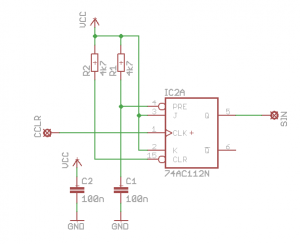Nilquader and I decided to release our Verilog code (based on Nocash’s decryption of the algorithm) to “emulate” the ACID protection chip of the Amstrad Plus. So, you can now find it in the [[Amstrad Cartridge Identification Device|ACID article]] of the CPCWiki and right here in this posting:
`timescale 1ns / 1ps
//////////////////////////////////////////////////////////////////////////////////
// Company:
// Engineer: Octoate, Nilquader
// ACID Reverse engineering by nocash
//
// Create Date : 00:45:53 09/03/2010
// Design Name : amsacid
// Module Name : amsacid
// Project Name :
// Target Devices: Xilinx XC9572
// Tool versions :
// Description : Reverse engineered Amstrad 40908 "ACID" Chip
//
// Revision:
// Revision 0.05
// Additional Comments:
//
//////////////////////////////////////////////////////////////////////////////////
module amsacid(PinCLK, PinA, PinOE, PinCCLR, PinSIN);
input PinCLK;
input [7:0]PinA;
input PinOE;
input PinCCLR;
output [7:0]PinSIN;
wire PinCLK;
reg [16:0]ShiftReg = 17'h1FFFF;
wire [16:0]CmpVal;
wire [16:0]XorVal;
assign CmpVal = 17'h13596 ^ (PinA[0] ? 17'h0000c : 0)
^ (PinA[1] ? 17'h06000 : 0)
^ (PinA[2] ? 17'h000c0 : 0)
^ (PinA[3] ? 17'h00030 : 0)
^ (PinA[4] ? 17'h18000 : 0)
^ (PinA[5] ? 17'h00003 : 0)
^ (PinA[6] ? 17'h00600 : 0)
^ (PinA[7] ? 17'h01800 : 0);
assign XorVal = 17'h0C820 ^ (PinA[0] ? 17'h00004 : 0)
^ (PinA[1] ? 17'h06000 : 0)
^ (PinA[2] ? 17'h00080 : 0)
^ (PinA[3] ? 17'h00020 : 0)
^ (PinA[4] ? 17'h08000 : 0)
^ (PinA[5] ? 17'h00000 : 0)
^ (PinA[6] ? 17'h00000 : 0)
^ (PinA[7] ? 17'h00800 : 0);
always@(negedge PinCLK)
begin
if (PinCCLR) // not in reset state
begin
if (!PinOE && ((ShiftReg | 17'h00100) == CmpVal))
begin
ShiftReg <= (ShiftReg ^ XorVal) >> 1;
ShiftReg[16] <= ShiftReg[0] ^ ShiftReg[9] ^ ShiftReg[12] ^ ShiftReg[16] ^ XorVal[0]; // hier xorval mit berüchsichtigen
end
else
begin
ShiftReg <= ShiftReg >> 1;
ShiftReg[16] <= ShiftReg[0] ^ ShiftReg[9] ^ ShiftReg[12] ^ ShiftReg[16];
end
end
else
begin
ShiftReg <= 17'h1FFFF;
end
end
//assign PinSIN = ShiftReg[7:0] ^ 8'hff;
assign PinSIN = ShiftReg[7:0];
//assign PinSIN[0] = PinCLK;
endmodule
But this isn’t everything about the ACID. We also found a timing problem during the investigation with a logic analyzer, which you can see here:
You will find glitches on the /CCLR line which show that the SIN contact should be changed… All in all it is possible to use a fast flip-flop to change the SIN signal when such a glitch occurs (see picture below).
You see, this is a very simple schematic, but it isn’t much cheaper than a CPLD, which emulates the full ACID and it comes with a disadvantage: it won’t work with a reset, so you always have to switch the CPC off and on again.
So, have fun with it – maybe Bryce will change his cartridge design and support this solution in the future :-).



[…] Bruja ACID Verilog code release » Apr 15 […]